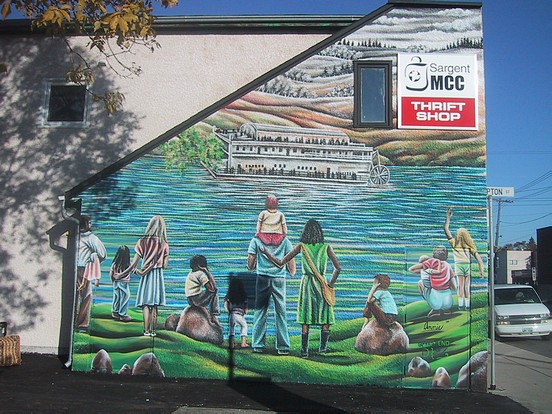|
|
|
|
|
|





|
|
859 Sargent Avenue
Location Map

"Migration of the Mennonites".
|
Location: NE corner Sargent & Lipton; West Face
Occupant: Big Sand, formerly Sargent (MCC) Thrift Store
District: West End
Neighbourhood: Daniel McIntyre
Artist(s): Annie Bergen
Year: 2006
Sponsors: West End BIZ
|
|
|
Annie Bergen: "On account of my love for thrift-store shopping and my Mennonite heritage, I was thrilled to have been asked to paint this wall.
The subject I could easily relate to, the location couldn't have been better, and I got to practice my Low-German conversing with
the wonderful staff and volunteers at the MCC. The scene depicts my interpretation of the first major wave of Mennonite migration
from Russia to the prairies in the late 19th century. They came via the United-States on massive paddlewheel steamships,
ultimately landing on the Rat and Red river."
"The background - painted in black and white, bleeding into sepia - represents the first generation of migrants.
The people who are painted in colour and standing in the foreground are their offspring. Although they all share a common history,
for the most part they are indistinguishable from the rest of main-stream society. However, by looking back to their ancestors - those who
stood before them - they are paying homage to their distinctive past. Still, they are separated by the river which symbolizes the generational gap
that typically occurs when different generations of families are brought up in different lands."
The Mural was unveiled to an enthusiastic public gathering the following spring on April
24, 2007:
Dolores Lohrenz (President of Sargent and Selkirk Thrift Shops, Winnipeg): "Since the
Mural is titled Migration of the Mennonites, I will fill you in on our first links to
the Forks. In 1873, by invitation of William Hespeler, ten delegates from the Ukraine
and Russia arrived in Manitoba to see if they considered the prairies a suitable place to
emigrate with their families. The ten men arrived at the Forks on the
International, the boat pictured here, and toured prospective sites on horseback.
Two of the delegates on this exploratory mission decided to recommend Manitoba as
having great potential for their future homes. It is of great pride to me that one of those
two men was my great, great grandfather, David Klassen. Back in Russia, many packed
up and sold their homesteads, and from1874 to 1876 about 7000 Mennonites arrived in
Manitoba. At this time the city of Winnipeg had only about 5000 people, fewer than this
immigrant group, but the new settlers headed for outlying areas and worked at setting up
farms. Today, we hop cars, trains, planes, but listen to how these families got here.
Sleighs and horses to Moscow, to Hamburg by train, then by ship to England, on a boat
from Liverpool Harbour to Quebec City, by rail to the Great Lakes, across to Duluth on
ships, train to Fargo where they finally boarded the steam ship International. Many left
the steamer at the mouth of the Rat River, some went on to Winnipeg. Horses and oxen,
some pulling covered wagons, provided transport to their future farm sites. Mennonites
continued to migrate in smaller clusters with another major group arriving in the 20s and
another in the 40s after the Second World War. Those coming later missed out on the
long, arduous trek and certainly the thrills of riding the steamer, International."
"As a symbol of remembrance, Annie has reproduced the International docked at the
Forks. The shoreline is filled with our ancestors and others who have come from
countries all over the globe to make Manitoba their home. This is truly the richness of
our country - that we arrive from many places and become one family."
"We have had only positive comments on the mural. "We like the brightness. I love the
young people sitting on their parent's shoulders. The spectrum from snow up North to
summer at the forks is neat. It looks so inviting. The influence on the neighbourhood
must be positive and pleasant." I'm sure we will hear many more comments. To us the
artistry is a source of pride. We welcome it as a beautiful tool to combat graffiti and as a
positive enhancement to the neighbourhood. We hope it also says 'come into our shop,
you are always welcome'. We are all one family of Winnipeggers!"
|
|